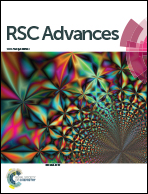Synthesis of MacMillan catalyst modified with ionic liquid as a recoverable catalyst for asymmetric Diels–Alder reaction†
Abstract
MacMillan catalyst was modified with imidazolium ionic liquid by ester linkage and acts as recoverable and reusable catalyst for asymmetric Diels–Alder reactions. A Diels–Alder reaction between cyclopentadiene and crotonaldehyde was carried out using MacMillan catalyst modified with ionic liquid (5 mol%) using trifluoroacetic acid (5 mol%) as co-catalyst in acetonitrile–water (95 : 5) at room temperature, to give 94% conversion of Diels–Alder adduct with exo/endo (1 : 1.1) and 90% ee of endo product. The catalyst was recovered and reused up to 5 cycles with a slight decrease in ee and product conversion.


 Please wait while we load your content...
Please wait while we load your content...